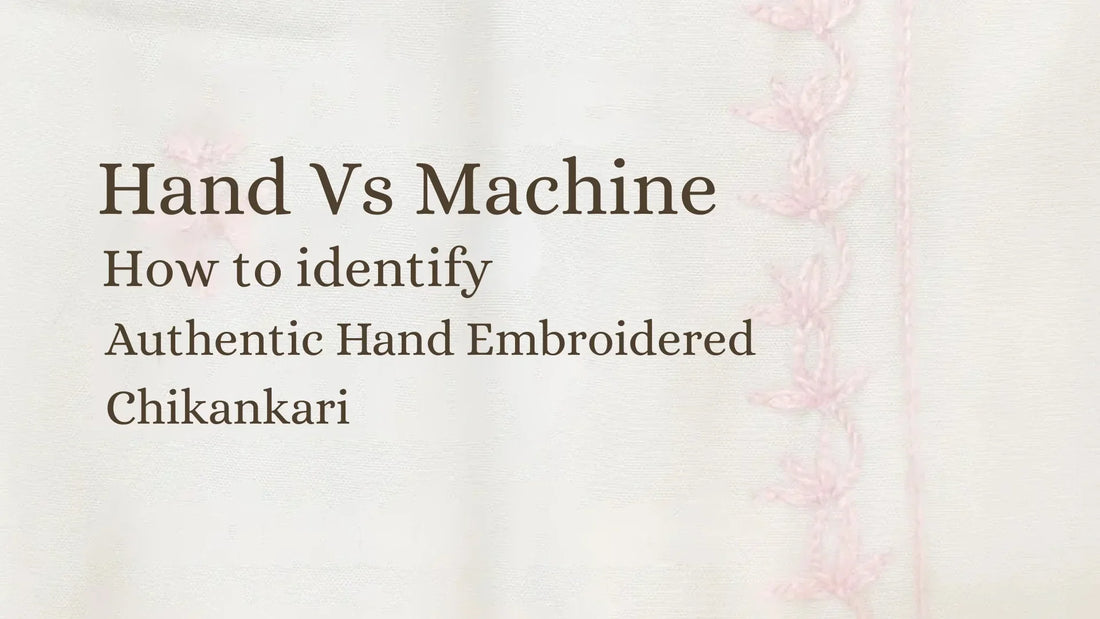
Hand vs. Machine: How to Identify Authentic Hand-Embroidered Chikankari
Share
A Story Woven by Hands, Not Just Threads
Imagine this: You walk into a store or scroll through a page filled with beautiful white-on-pastel embroidery. The tag reads “Chikankari,” but… is it really the timeless handwork that echoes centuries of tradition — or is it mass-produced, machine-stamped imitation?
In an age where machine embroidery mimics everything, knowing how to spot real, hand-embroidered Chikankari is both an art and an appreciation. Let’s unravel it, thread by thread.
What is Authentic Chikankari?
Chikankari is a traditional embroidery technique that originated in Lucknow, India — known for its delicate floral motifs, subtle shadow work, and stitches like bakhiya, phanda, murri, and jali. Each piece takes days, sometimes weeks, to complete — done by women artisans sitting in their courtyards, working in silence and sync.
In contrast, machine embroidery often uses uniform patterns, synthetic threads, and automated stitching that lacks soul — and unfortunately, is now mass-marketed as “Chikankari”.
Hand vs. Machine: Key Differences You Can Spot
1. Irregularity is Beauty
Hand Chikankari has slight imperfections — no two phandas are the same. That’s the charm.
Machine-made pieces look too perfect, too aligned. Every motif is copy-paste.

Tip: Flip the fabric — on real handwork, the back will look slightly messy. Machine work is too neat underneath.

2. Feel the Fabric, Feel the Story
Hand embroidery sits within the fabric, almost blending into the weave.
Machine embroidery feels raised, stiff, and often harsh to touch.
🌿 Real Chikankari feels soft, like it belongs to the fabric, not on top of it.
3. Stitch Techniques Give it Away
A trained eye can spot a Murri or Bakhiya stitch — these are hard to replicate by machine.

Pro Tip: Use a magnifying glass. If the threads loop inconsistently and enter the fabric from different angles, it’s hand-done.
4. Price Tag = Time Tag
Hand embroidery is time-consuming. It shows in the price. If someone’s selling a “pure Chikankari kurta” for ₹800 — chances are it’s machine-made.
Authentic Chikankari is slow fashion. You’re not just paying for the product — you’re paying for the artisan’s time, skill, and story.
Where Can You Buy Authentic Hand Chikankari?
At Shwet Artistry, every piece is hand-embroidered by women artisans from Lucknow and surrounding villages. We don’t mass-produce. We don’t cut corners. We create heirlooms, not inventory.
Whether it’s a festive Chikankari saree, a daily-wear kurta, or an elegant wedding dupatta, our designs are rooted in heritage — and handwoven with love.
Why It Matters
Choosing authentic Chikankari isn’t just about buying fashion — it’s about preserving tradition, empowering rural artisans, and standing up for slow, soulful craft in a fast-paced world.
So next time you’re tempted by that “handcrafted” label, take a closer look.
Sometimes, the thread tells the truth.
